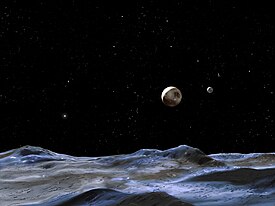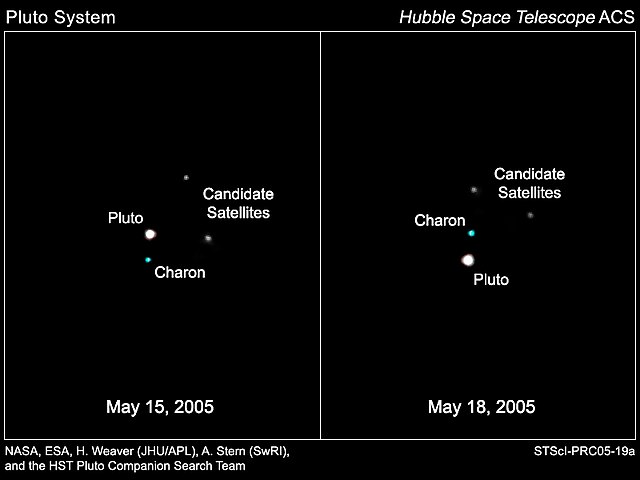outermost known natural satellite of Pluto From Wikipedia, the free encyclopedia
Hydra is the farthest moon of Pluto. It was found along with Nix in June, 2005 by the Hubble Space Telescope's Pluto Companion Search Team, which is composed of Hal A. Weaver, Alan Stern, Max J. Mutchler, Andrew J. Steffl, Marc W. Buie, William J. Merline, John R. Spencer, Eliot F. Young, and Leslie A. Young. The discovery images were taken on May 15, 2005 and May 18, 2005; the moons were independently found by Max J. Mutchler on June 15, 2005 and Andrew J. Steffl on August 15, 2005. The discoveries were announced on October 31, 2005, after confirmation by precoveries from 2002. The moons were provisionally designated S/2005 P 1 (Hydra) and S/2005 P 2 (Nix).[5][6]
 Artist conception of Hydra (foreground), Pluto and Charon (background), and Nix (bright dot center left) | |
| Discovery | |
|---|---|
| Discovered by | Hubble Space Telescope Pluto Companion Search Team |
| Discovered in | June 2005 |
| Orbital characteristics[1] | |
| Semi-major axisa | 64 780 ± 90 km |
| Eccentricity | 0.005 ± 0.001 |
| Orbital period | 38.206 ± 0.001 d |
| Inclinationb | 0.22° ± 0.12° |
| Is a moon of | Pluto |
| Physical characteristics | |
| Mean diameter | 61 − 167 km[2] |
| Mass | 5×1016 − 2×1018 kg[3] |
| Mean density | unknown |
| Rotation period | unknown |
| Axial tilt | unknown |
| Albedo | 0.04 − 0.35 (assumed)[4] |
| Apparent magnitude | 22.9 to 23.3 (measured)[4] |
| Surface temp. | 33-55 K |
| Atmosphere | none |
|
| |
| a Relative to the Pluto-Charon barycenter. b Relative to Pluto's equator (also Charon's orbital plane). | |
The moon orbits the barycenter of the system in the same plane as Charon and Nix, at a distance of about 65,000 km. Unlike other moons of Pluto, its orbit is only nearly circular; its eccentricity of 0.0052 is small, but significantly non-zero. Its orbital period of 38.2 days.

Although its size has not been directly measured, calculations based on its brightness give it a diameter of between 61 km, if its reflectivity is similar to Charon's 35 percent, and about 167 km, if it has a reflectivity of 4 percent like the darkest Kuiper belt objects (KBOs).[2] At the time of discovery, Hydra was about 25 percent brighter than its sister moon Nix, which led to the assumption that its diameter was some 10 percent bigger.[7] Pre-discovery data from Hubble observations in 2002-3 inferred that Nix was the brighter moon.[1] However, Hubble observations in 2005-6, specifically targeting the dim moons, once again showed Hydra to be a little brighter.[4] Hydra appears to be grey like Charon and Nix, though Pluto is reddish.
Hydra was to be visited along with Pluto by the New Horizons mission in 2015.
The name Hydra was announced on June 21, 2006, in IAU Circular 8723,[6] along with the formal designation Pluto III. It was named after Hydra, the monster who guarded the waters of Pluto/Hades's underworld in Greco-Roman mythology.
Seamless Wikipedia browsing. On steroids.
Every time you click a link to Wikipedia, Wiktionary or Wikiquote in your browser's search results, it will show the modern Wikiwand interface.
Wikiwand extension is a five stars, simple, with minimum permission required to keep your browsing private, safe and transparent.